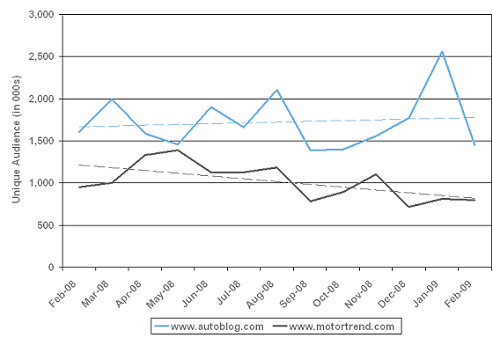By Joe Colacurcio
Recently, several online automotive enthusiast blogs have taken unique opportunities to directly engage with their audiences via live, combined chats, integrating commonly utilized platforms such as Twitter.com and the blogs themselves. This type of direct engagement shows the continually evolving potential for such enthusiast channels to form new “touch points” and influence online consumers in new ways.
On February 18, 2009, editors of the blogs Autoblog.com, Jalopnik.com, and KickingTires.com joined up for a live chat with online automotive enthusiasts to facilitate discussion and field questions regarding the viability plans of GM and Chrysler. Via their Web sites and Twitter, editors John Neff (Autoblog), Ray Wert (Jalopnik) and Dave Thomas (KickingTires), actively engaged audiences in conversation regarding this very hot topic. Again on March 18, 2009, the trio of site editors took a similar approach, but this time invited Jon Lauckner, GM’s Vice President of Global Program Management. This gave enthusiasts and consumers the chance to communicate with an industry executive responsible for a controversial and highly anticipated product – the Chevrolet Volt.
For the social media managers and marketers, as well as traditional print media, this level of direct engagement between non-traditional information sources and audiences raises significant questions regarding the power of influential blogs as a new currency for information and opinion dissemination.
– As enthusiasts and consumers gain exposure to these types of live chats with influential editors of major blogs, how can brands – automakers in this case – leverage social media effectively to equip these influencers with the right information at the right time? What type and degree of engagement is appropriate, if any?
– Does evolving communication between influential bloggers and online enthusiasts act as a harbinger for decreased influence of traditional media venues in the automotive industry? Will the opinions of traditional media editors, such as magazines, lose significance?
Consider too, that in the past year, Autoblog.com has consistently seen Web site traffic above that of MotorTrend.com, the Web site incarnation of the widely circulated monthly publication of the same name.
Over the course of the twelve month period Autoblog.com traffic trends slightly upward, due in part to strongly received coverage of the 2009 Detroit Auto Show in January. As measured by unique audience, MotorTrend.com does not show similar strength as an online information disseminator, even during the Auto Show.

Source: Nielsen NetView, U.S., Home & Work
In any case, there are growing indications that what used to be more niche information venues are now making new efforts and potentially gaining traction among consumers and enthusiasts online. For social media marketers and managers, the question becomes how to understand and leverage opportunities with these influencers. For online versions of traditional print magazines, the question may be how best to compete.


